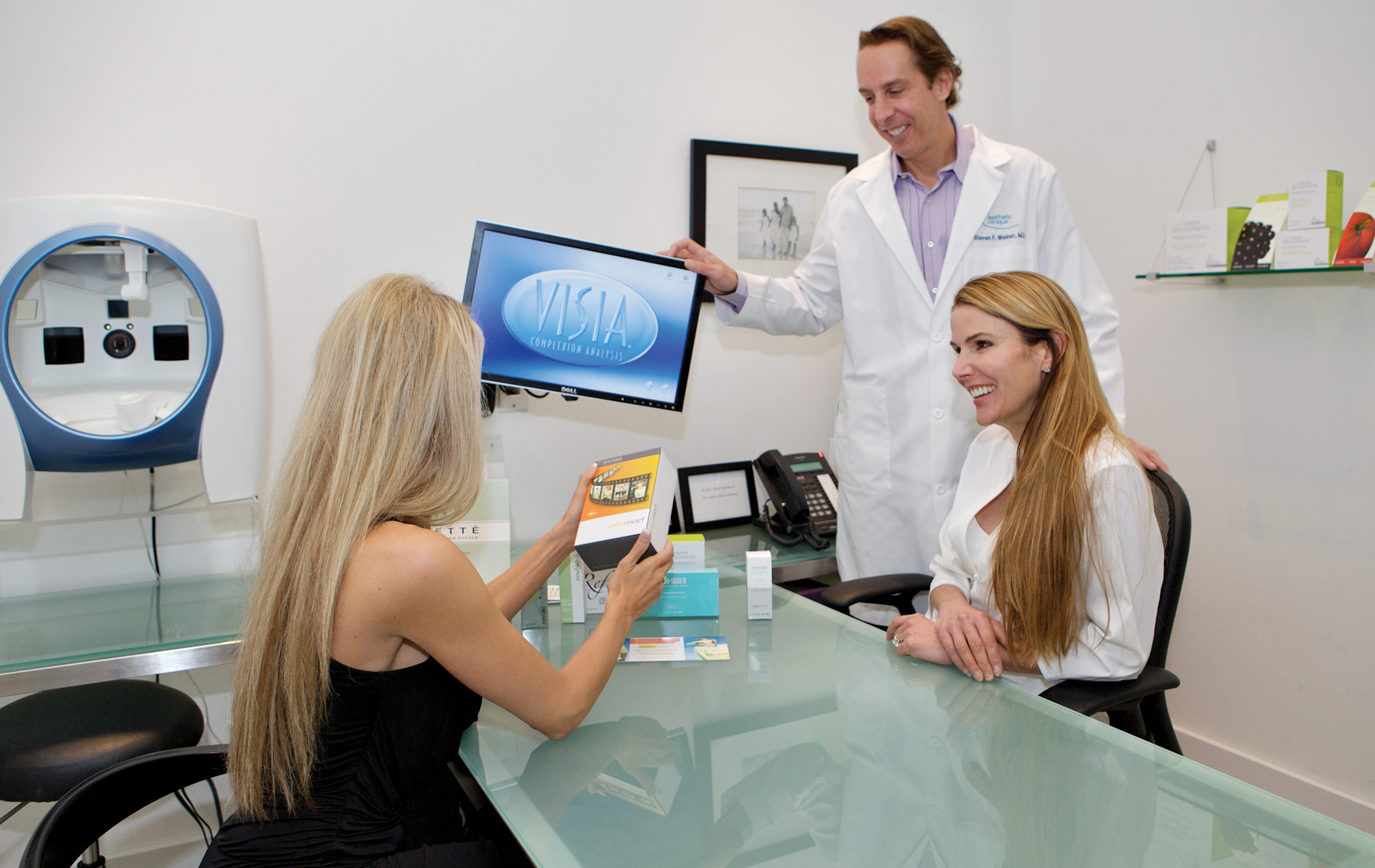
vie-magazine-dr-weiner-feature
Dr. Steven Weiner
By Sallie W. Boyles
In the five years since he opened The Aesthetic Clinique, board-certified head, neck, and facial plastic surgeon Dr. Steven Weiner has gained national recognition among his peers as a leader in noninvasive and minimally invasive cosmetic procedures. There’s no question that he chose to be an early adopter of cutting-edge technologies at the right time and place, but this multifaceted professional maximized his opportunities through well-calculated decisions, not luck.
So, what lies at the heart of his practice, which appears to function effortlessly? Dr. Weiner offers an inside look at the intense preparation and passion that deliver the patient-pleasing results that drive his success.
Before
As an undergraduate at UCLA, Steven Weiner took a mix of courses—physics, physical chemistry, calculus—that could have placed him on an engineering or a physics track. He appreciated the disciplines that required precision, including the mathematics of chemistry. From a PBS series featuring the doctor’s craniofacial surgeries on children with cleft palates and other head abnormalities, Weiner had observed the work of renowned French surgeon Paul Tessier (1917–2008), and he grew fascinated with skeletal features. The program made him aware of a plastic surgeon’s power to change a person’s looks and, likewise, the individual’s quality of life.
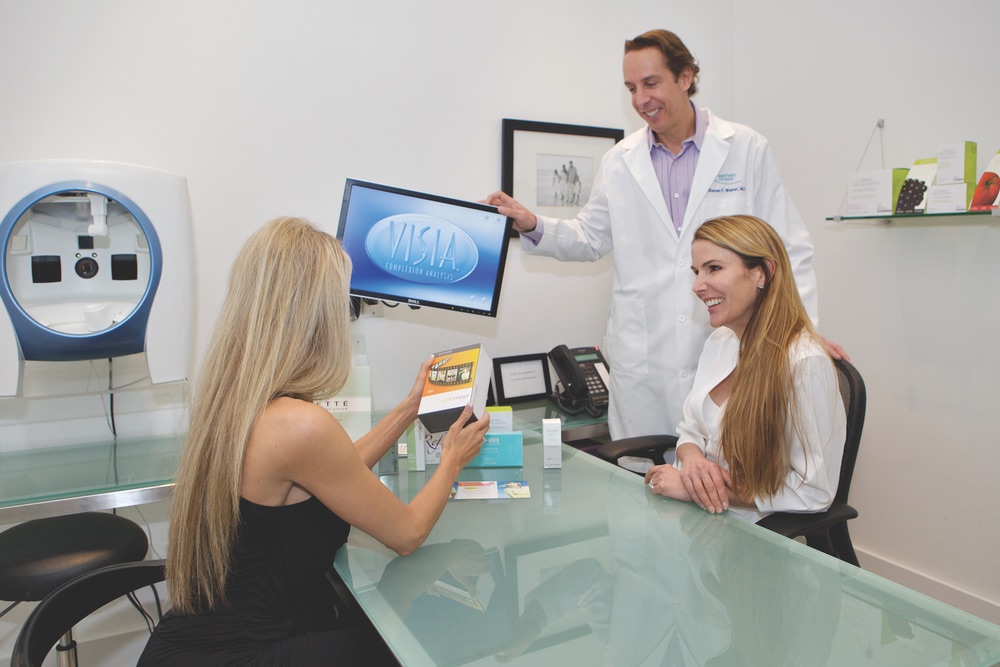
Excelling in medical school at the University of Michigan, he went to Johns Hopkins Hospital to intern and fulfill his residency requirements. Weiner was in the right place to focus on his specialty, as Johns Hopkins ranks first in the nation for head and neck surgery.
“Interestingly, before Botox became the cure for wrinkles, we were using it at Johns Hopkins for larynx disorders and neck spasms,” says Weiner. “Our patients included a nationally known radio personality who suffered with a Parkinson’s-related symptom that caused her voice to get raspy. Botox treatments helped her vocal cords relax.” Practicing there and serving on the hospital’s faculty for two years, Weiner was grateful to work alongside the world’s most brilliant doctors, many of whom represented the “pinnacle of knowledge” regarding certain disease processes.
After seven years at Johns Hopkins, however, Weiner’s priorities shifted. He and his wife, Sandy, had started a family, and living in a safe, small town became more important than working for a prestigious hospital. When a recruiter came along with a lucrative opportunity that would allow him to open a solo Head and Neck Surgery practice in Thomasville, Georgia, Weiner accepted.
“I practiced all kinds of medicine in Thomasville,” says Weiner, who treated a large number of cancer patients there. “Plastics were a small part of the mix.” He remained in south Georgia for ten years, all the while preparing the groundwork for his next move, which was motivated by two distinct passions: investing in the stock market and learning about the innovations changing Plastic Surgery.
Weiner came by his knack for investing quite honestly. First, he loved practical math such as graphing and charting trends. Second, his dad dabbled in stocks, and that sparked his interest in the market. To become an educated investor, he read books and attended conferences, and when the Internet unleashed a world of trading options, he went after them.
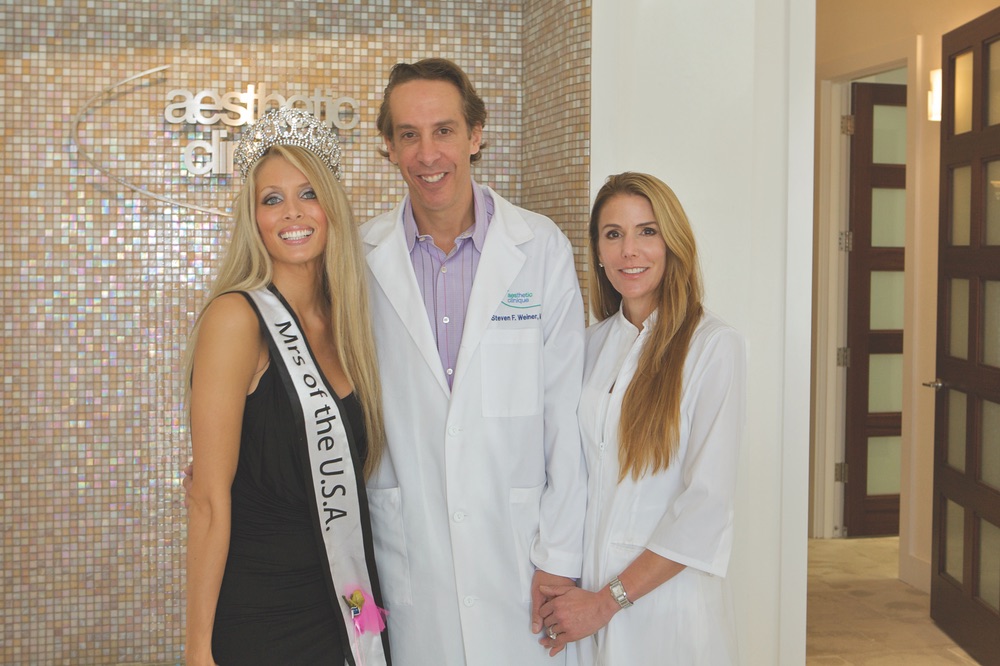
“I’m a swing trader,” Weiner says, meaning that he makes daily and weekly buying and selling decisions relative to market volatility caused by events around the world. “I spot trends,” he adds, explaining that he relies on critical observations to determine his subsequent steps. Typically holding any particular stock for two days to two weeks, Weiner explains that he is happy to earn small gains rather than risk hanging on for big killings. “Greed leads to bad decisions; it’s what caused the major problems we experienced in the housing and stock markets,” he adds. “I sold five profitable pieces of real estate in 2005, although people said I was letting them go too early.” He could have waited, but he sold well before the market plummeted.
“The stock market has taught me a great deal about calculating risks,” Weiner says, drawing a comparison between investing and practicing medicine. “There’s no sure thing in the market or in medicine, so whether I’m evaluating a stock or a patient’s skin, I rely upon expertise, background information, and probabilities to apply an educated guess. Even then, I have backstops or assurances in place to minimize negative outcomes. As a result, I’m ever aware of the changing situation and always ready to respond. I’m constantly reassessing conditions with my eyes wide open.”
The strategy has served Weiner and a few others quite well. While in Thomasville, he managed his employees’ 401(k) accounts. “I made sure they understood the risks and asked each to sign waivers, but I always felt a huge responsibility toward them.” In the end, his decisions paid off. “The returns amounted to ten times their original investments,” says Weiner.
At the same time, his personal investments were richly rewarding. That money, however, was hard earned. “I had large amounts invested, so I was up at 2 a.m. many nights checking futures to confirm that I was buying and selling correctly.” When he was ready to cash in, Weiner chose to relocate his family to Rosemary Beach, where they most wanted to live, and launch a brand-new practice.
Along with living on the Emerald Coast, Weiner seized the opportunity to enter the field of Aesthetic Medicine, which he had been proactively researching. Weiner acknowledges that it’s extremely rare for a physician to start over, but critical factors were in his favor. Rather than viewing the move as a major risk, he recognized the strong potential that laser treatments and other innovative procedures presented to patients using his twenty-two years of laser and sixteen years of Botox experience.
After
Consumer demand, coupled with Weiner’s commitment to learn and master techniques, have made him a respected go-to resource for minimally invasive aesthetic treatments. In fact, Weiner outgrew his original 800-square-foot space in Gulf Place after just six months. His primary office, a beautifully sleek yet comfortable facility in Santa Rosa Beach, is open Monday through Saturday. He also maintains a smaller satellite office situated twelve miles east in the trendy New Urbanist town of Rosemary Beach. Even in a down economy, his appointment schedule remains booked.
Across the country, the demand for laser resurfacing and Botox usage is up, while facelifts have dropped 29 percent over the past year. Meanwhile, manufacturers are generating press about all sorts of new products and treatments.
Although websites such as Realself.com can be highly informative with feedback from patients and physicians, Weiner cautions that sorting through products and procedures requires educated discernment, especially as innovations continue to expand the field of medical aesthetics. Likewise, to remain in the forefront, he faces an intense challenge to keep learning and discerning every step of the way.
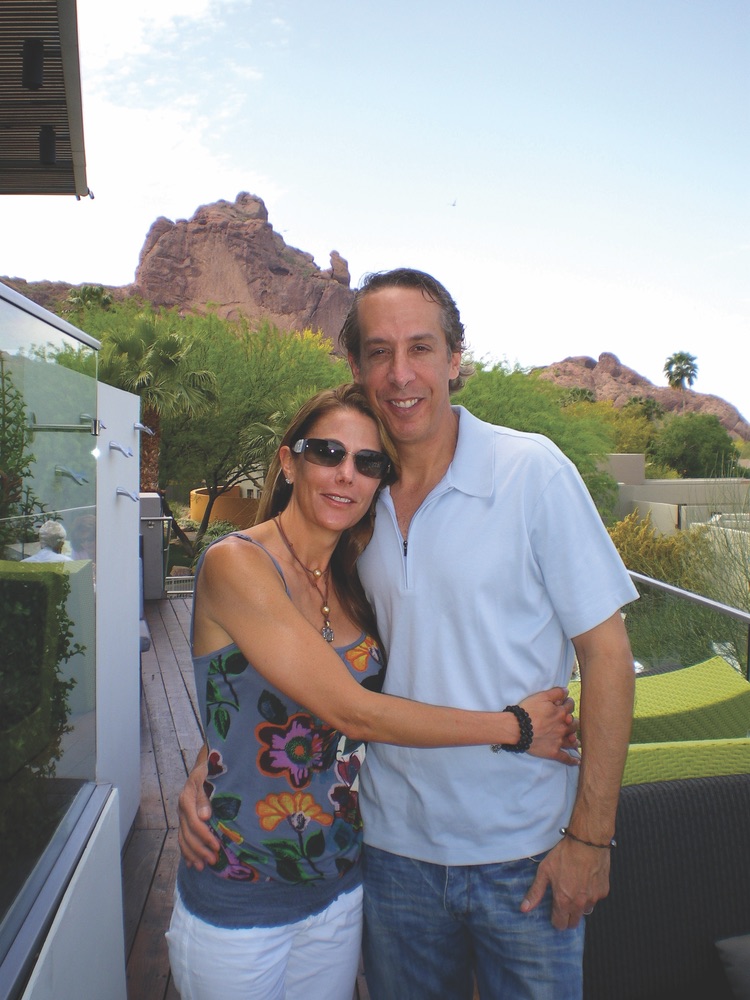
“Although patients trust and appreciate my expertise and results, I don’t believe they have any idea how much time and money I invest to do my job with their best interests at heart,” says Weiner. “Because advancements are happening so quickly, I can’t rely on medical journals for the facts I need,” he explains. “The most progressive products and procedures are shared at conferences, so that’s where I have to be.”
In the three weeks prior to this interview, for instance, Weiner had attended symposiums in Boston, Washington, D.C., and New Orleans, and his immediate plans included a fourth on Amelia Island. “This year, I’ve attended three conferences featuring speaker Rox Anderson, who is the primary innovator of medical laser applications in the world and represents the forefront of laser innovations.” Gaining insights as well as passing them along to other physicians, Weiner further confers regularly with a network of plastic surgeons through e-mails and phone calls.
In addition to consulting with his professional colleagues, Weiner works closely with equipment manufacturers. “Establishing direct lines of communication with CEOs and research teams of the companies that develop this technology is essential to staying in the loop,” says Weiner. “An advantage of being an early adopter, too, is the ability to provide feedback that sometimes influences product design. I recently went back and forth with the developers of a new laser machine, and after six months of negotiations, they changed the prototype to incorporate my recommendations.”
Manufacturers additionally appreciate Weiner’s willingness to serve as a referral resource for doctors who have questions about techniques. “I traveled to three different physicians to learn the newest liposuction technique of Body-Jet® Water-Jet Assisted Liposuction,” says Weiner. Similarly, Fraxel showcases Weiner’s before-and-after patient studies to market their lasers.
Despite his value to the manufacturers, Weiner does not get free equipment. “I’m heavily invested in my machines, which average about one hundred thousand dollars each,” he says. After the initial purchase, he continues to pay per usage. “The lasers have to be recalibrated and have a lifespan of about 2–3 years,” Weiner explains, “and disposable parts are replaced after every few applications.”
Still, he does not dispute the incremental charges. “I’d rather buy from a business that generates healthy streams of income than from one that is strapped for cash. Revenues keep these companies on solid financial ground as well as provide funding for continued research.”
Weiner further cautions that while doctors in larger cities can reduce costs by leasing equipment that they share among different practices, he does not feel those programs are an advantage to patients. “For top-notch performance, this equipment must be used and maintained properly by well-trained personnel,” he says. “As the sole owner and operator of my lasers, I guarantee that they are functioning optimally. I couldn’t relay that level of assurance to my patients without the controls I have through ownership.”
Similarly, Weiner assumes full responsibility for performing certain procedures—such as laser hair removal, filler treatments, and Botox—that physicians’ assistants and nurse practitioners would routinely handle in other clinics. “Patients come to my office for my expertise,” he says.
“Because advancements are happening so quickly, I can’t rely on medical journals for the facts I need,” he explains. “The most progressive products and procedures are shared at conferences, so that’s where I have to be.”
Despite how busy he is with continuing education, consulting, and practicing, Weiner also manages functions such as payroll, accounting, and marketing for The Aesthetic Clinique. As someone who appreciates form and function, he also had a big part in designing his office’s furniture and interior spaces. “When I have a vision, I enjoy facilitating its creation,” adds Weiner, who also has overseen his billboard designs. He says, however, that his wife, Sandy—also his nurse—is his sounding board, and he relies heavily on her input.
All in all, Weiner appreciates variety, which is why he likes the stimulation inherent in his endlessly changing field of medicine. “My work is never boring,” he says.
Neither is his play. First running on the soccer field at the age of five, Weiner was captain of his high school team and later practiced with UCLA’s number-one ranking team while there. “With the courses I was taking, I didn’t have enough free time to be on a college team’s roster, but I continued to play games through medical school,” he says. And despite the current demands in his life, he still finds time for sports. “I play a pickup game of soccer every weekend that I’m in town,” he says. “These are wonderful opportunities to meet people from different lifestyles who come together to take part in a sport they love.” Afterwards, Weiner and his fellow players—who are originally from countries such as Chile, Colombia, Brazil, Germany, Russia, and Lithuania—congregate at The Red Bar in Grayton Beach. “I love that soccer has a purpose and goal, yet it’s also great exercise,” says Weiner, who was also the girls’ soccer coach for Seaside Neighborhood School until recent funding cuts eliminated the program.
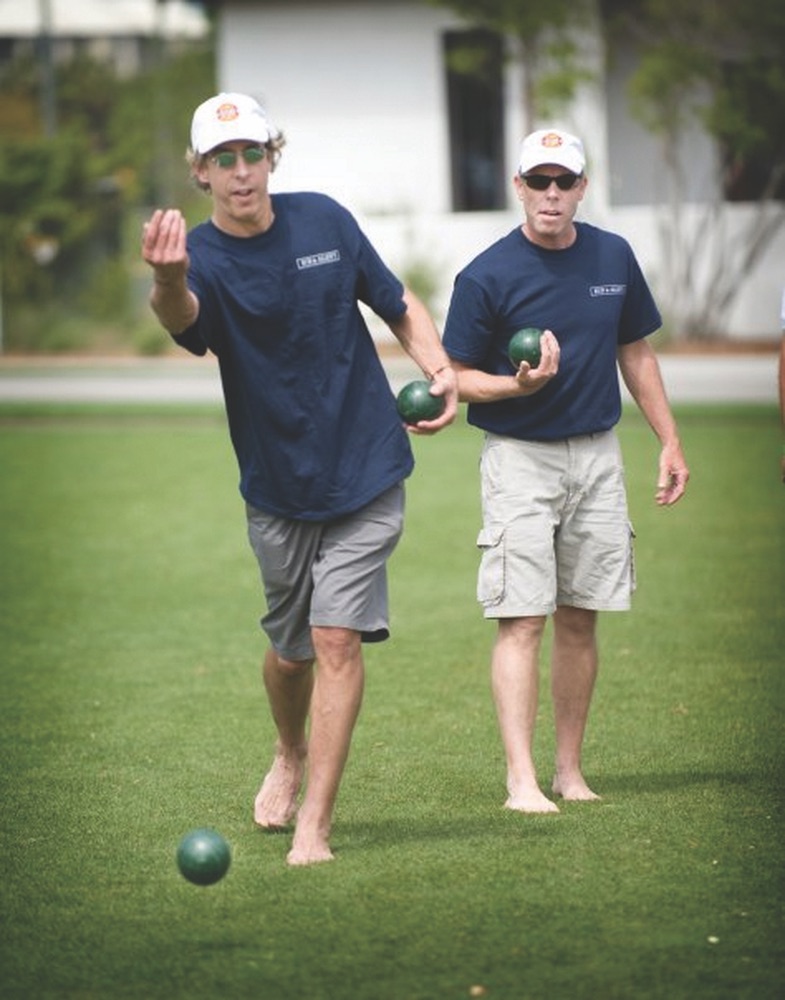
He has also taken up bocce ball, which was introduced to him by a fellow Rosemary Beach friend. “Several of us were playing regularly on the beach and decided to start our own tournament in 2006,” Weiner says. “We had about forty participants the first year, and one hundred twenty players are expected this fall.” The Rosemary Bocce Ball Tournament—a biannual (spring and fall) event—has become quite a production, honoring the sport’s Italian heritage with the fanfare of flags and music, plus a celebrity to toss the first ball.
Another of Weiner’s interests is collecting antique medical tools, many of which he has found on eBay. “I have old amputation saws from the Civic War period that look like torture devices,” he laughs. Rare laryngeal equipment and early plastic surgery tools are equally intriguing. “Sometimes, I’ll want only one item offered from a collection, so I’ll buy the full lot and resell the items I don’t care to keep.”
The buying and selling of antique medical tools, like the trading of stocks, might or might not take place at two in the morning but will happen efficiently. From having to maintain rigorous schedules at Johns Hopkins, Weiner acquired the disciplined time management skills that have since helped him prioritize and pursue his interests. Thus, as passionate as he is about medical aesthetics, Weiner will continue to live a multifaceted life. Above all, he will enjoy time with Sandy and their two daughters as he attempts to interest them in his hobbies.
He doesn’t know whether his girls will choose to study medicine, but Weiner plans to teach them to spot stock market trends. “I would love to give them the background to appreciate the trading process and to notice breakout stocks,” he says. “If I can teach them to spot trends for me, I’ll have time to focus on something new.”
Many would like to know just what the doctor has in mind.
— V —
Share This Story!
KEEP UP WITH THE LATEST STORIES FROM VIE
















































































































































